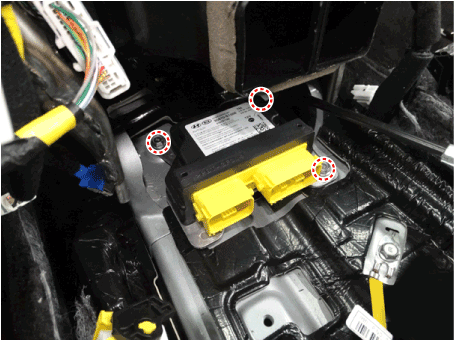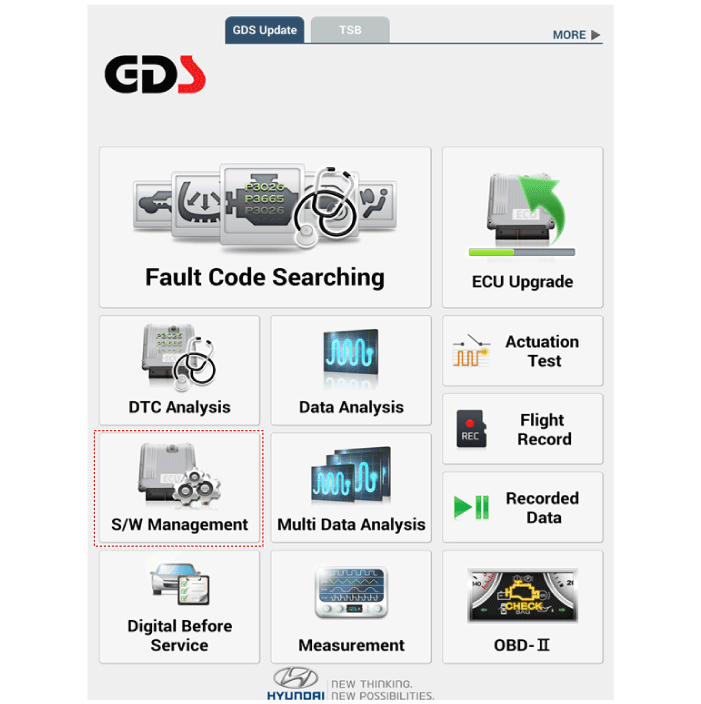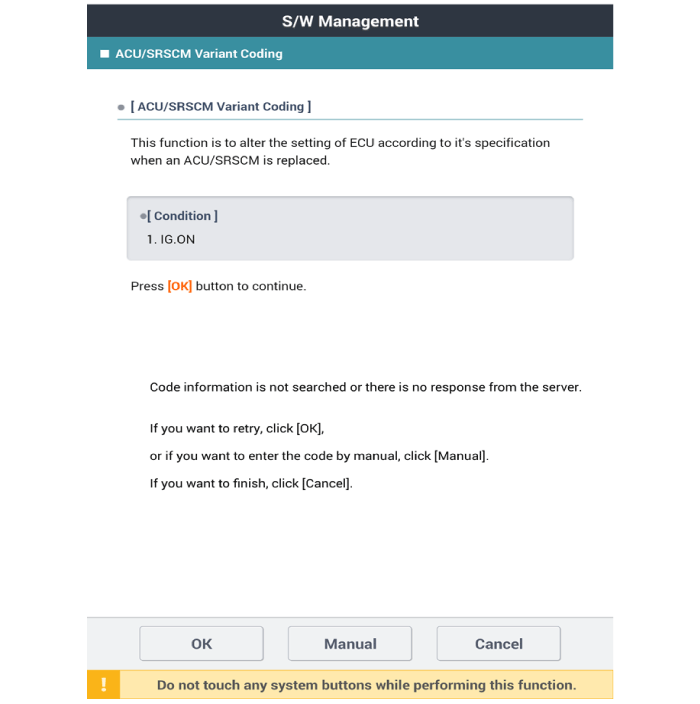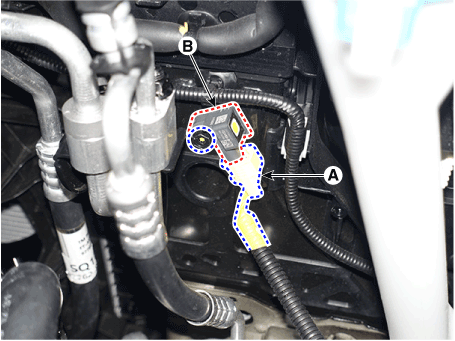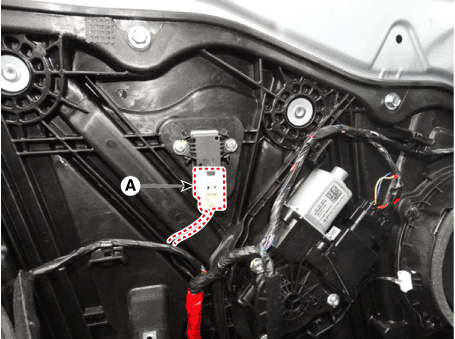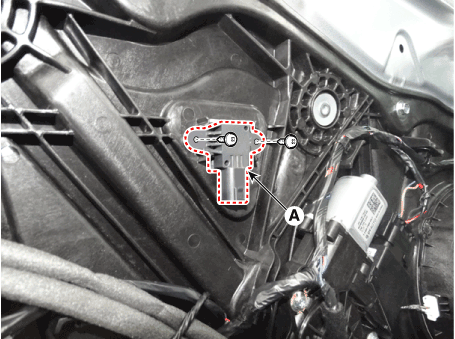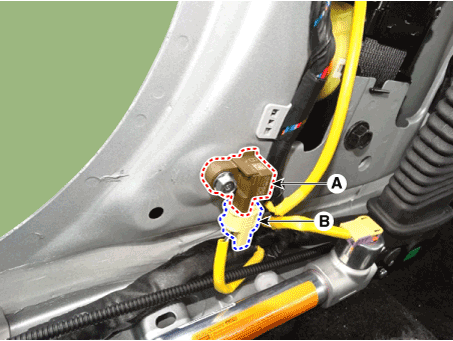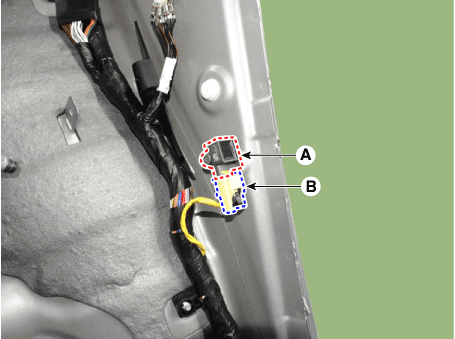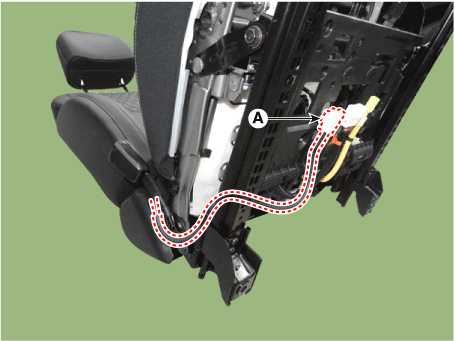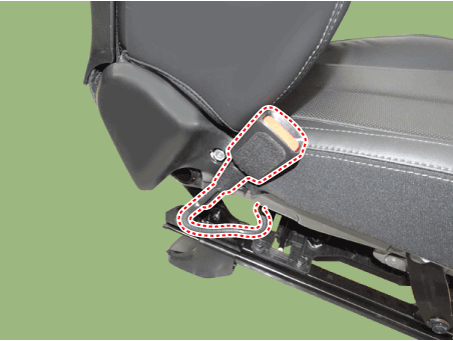 Hyundai Santa Fe (TM): SRSCM
Hyundai Santa Fe (TM): SRSCM
Components and components location
| Components |
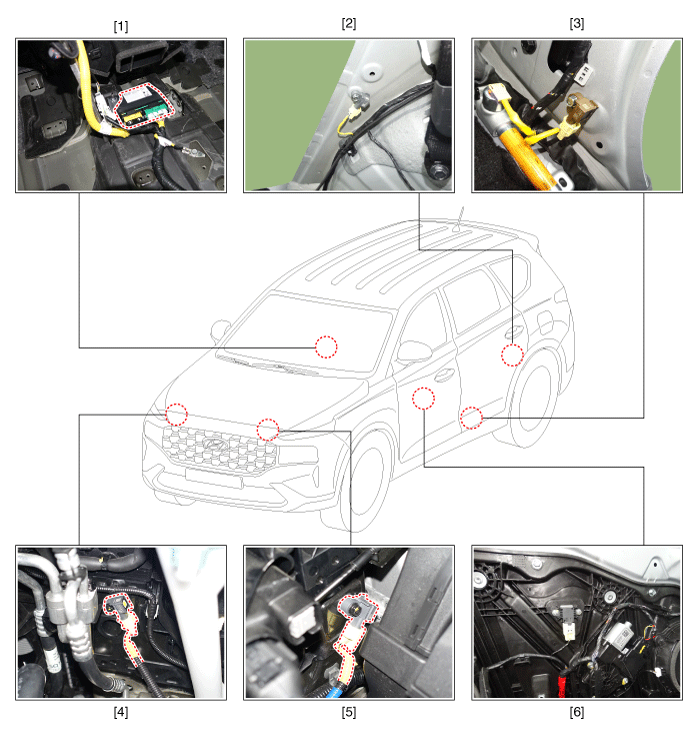
| 1. Supplemental
Restraint System Control Module (SRSCM) 2. Gravity side impact sensor (G-SIS) _ C pillar 3. Gravity side impact sensor (G-SIS) _ B pillar |
4. Front impact
sensor (FIS) [RH] 5. Front impact sensor (FIS) [LH] 6. Pressure side impact sensor (P-SIS) |
Schematic diagrams
| Circuit Diagram |
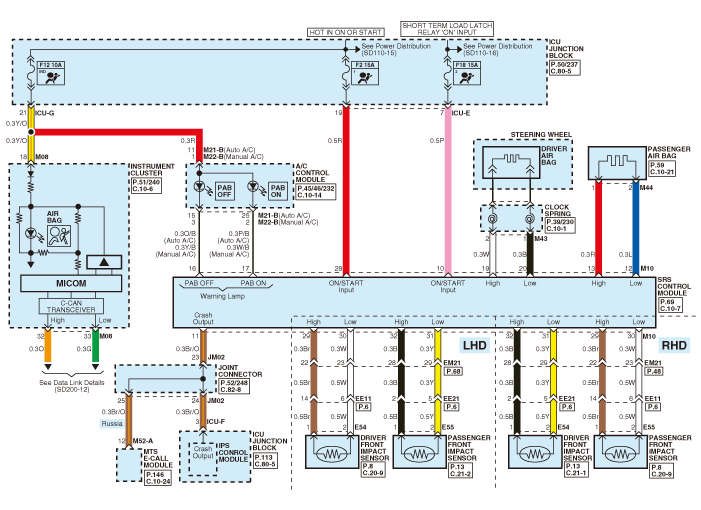
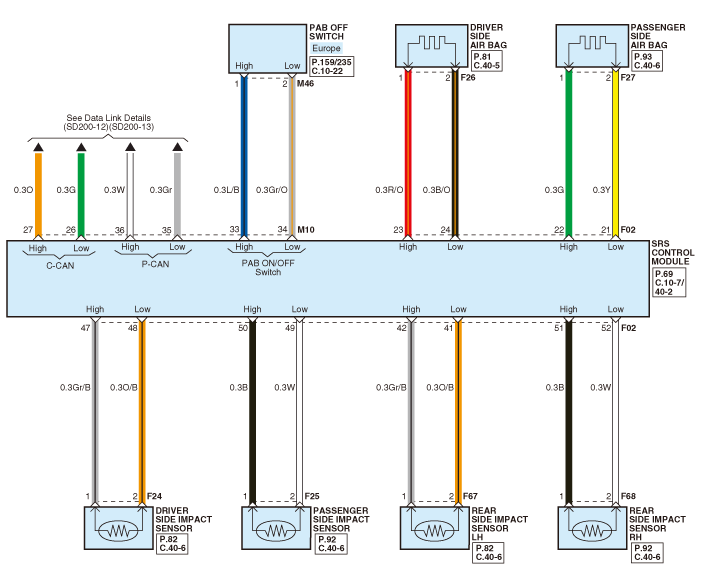
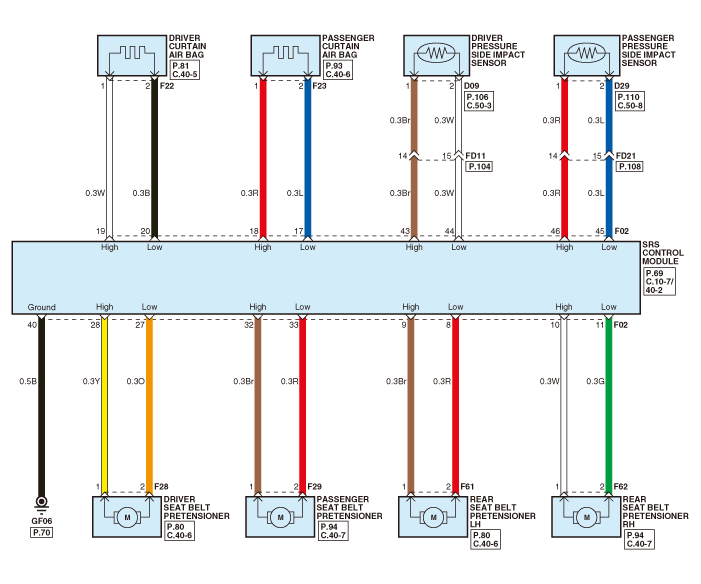
SRS Control Module (SRSCM). Description and operation
| Description |
The primary purpose of the SRSCM (Supplemental Restraints System Control Module)
is to discriminate between an event that warrants restraint system deployment
and an event that does not. The SRSCM must decide whether to deploy the restraint
system or not. After determining that pretensioners and/or airbag deployment
is required, the SRSCM must supply sufficient power to the pretensioners and
airbag igniters to initiate deployment.
The SRSCM determines that an impact may require deployment of the pretensioners
and airbags from data obtained from impact sensors and other components in conjunction
with a safing function.
The SRSCM will not be ready to detect a crash or to activate the restraint system
devices until the signals in the SRSCM circuitry is stabilized.
It is possible that the SRSCM could activate the safety restraint devices in
approximately 2 seconds but is guaranteed to fully function after prove-out
is completed.
The SRSCM must perform a diagnostic routine and light a system readiness indicator
when the ignition switch is in the ON position. The system must perform a continuous
diagnostic routine and provide fault notice through a warning lamp indicator
in the event of fault detection. A serial diagnostic communication interface
will be used to facilitate servicing of the restraint control system.
SRS Control Module (SRSCM). Components and components location
| Components |

| 1. Supplemental
Restraint System Control Module (SRSCM) |
SRS Control Module (SRSCM). Schematic diagrams
| Supplemental Restraint System Control Module (SRSCM) |

|
No |
Connector A |
Connector B |
|
1 |
Driver airbag 2st stage (High) |
- |
|
2 |
Driver airbag 2st stage (Low) |
- |
|
3 |
Passenger airbag 2st stage (Low) |
- |
|
4 |
Passenger airbag 2st stage (High) |
Driver seat belt anchor pretensioner (Low) |
|
5 |
- |
Driver seat belt anchor pretensioner (High) |
|
6 |
- |
Passenger seat belt anchor pretensioner (High) |
|
7 |
Passenger airbag active air vent (Low) |
Passenger seat belt anchor pretensioner (Low) |
|
8 |
Passenger airbag active air vent (High) |
|
|
9 |
- |
|
|
10 |
B+ |
|
|
11 |
Crash output |
|
|
12 |
Passenger airbag 1st stage (Low) |
|
|
13 |
Passenger airbag 1st stage (High) |
- |
|
14 |
- |
- |
|
15 |
- |
Passenger seat belt buckle sensor |
|
16 |
Telltale lamp |
- |
|
17 |
|
Passenger curtain airbag (Low) |
|
18 |
- |
Passenger curtain airbag (High) |
|
19 |
Driver airbag 1st stage - (High) |
Driver curtain airbag (High) |
|
20 |
Driver airbag 1st stage (Low) |
Driver curtain airbag (Low) |
|
21 |
- |
Passenger side airbag (Low) |
|
22 |
- |
Passenger side airbag (High) |
|
23 |
- |
Driver side airbag (High) |
|
24 |
- |
Driver side airbag (Low) |
|
25 |
- |
- |
|
26 |
C-CAN (Low) |
- |
|
27 |
C-CAN (High) |
Driver seat belt pretensioner (Low) |
|
28 |
IGN 1 |
Driver seat belt pretensioner (High) |
|
29 |
Front impact sensor LH - (High) |
- |
|
30 |
Front impact sensor LH - (Low) |
- |
|
31 |
Front impact sensor RH - (Low) |
- |
|
32 |
Front impact sensor RH - (High) |
Passenger seat belt pretensioner (High) |
|
33 |
|
Passenger seat belt pretensioner (Low) |
|
34 |
|
- |
|
35 |
P-CAN (Low) |
- |
|
36 |
P-CAN (High)) |
- |
|
37 |
|
- |
|
38 |
- |
|
|
39 |
- |
|
|
40 |
Ground |
|
|
41 |
Driver side rear impact sensor (Low) |
|
|
42 |
Driver side rear impact sensor (High) |
|
|
43 |
Driver pressure side impact sensor (High) |
|
|
44 |
Driver pressure side impact sensor (Low) |
|
|
45 |
Passenger pressure side impact sensor (Low) |
|
|
46 |
Passenger pressure side impact sensor (High) |
|
|
47 |
Driver side impact sensor (High) |
|
|
48 |
Driver side impact sensor (Low) |
|
|
49 |
Passenger side impact sensor (Low) |
|
|
50 |
Passenger side impact sensor (High) |
|
|
51 |
Passenger side rear impact sensor (High) |
|
|
52 |
Passenger side rear impact sensor (Low) |
SRS Control Module (SRSCM). Repair procedures
| Removal |
| 1. |
Turn the engine OFF.
|
| 2. |
Disconnect the battery negative cable and wait for at least three minutes
before beginning work.
|
| 3. |
Remove the floor console assembly.
(Refer to Body - "Floor Console Assembly")
|
| 4. |
Loosen the mounting bolts and then remove the air duct.
|
| 5. |
Pull up the lock of the SRSCM connector to disconnect the connector.
|
| 6. |
Remove the SRSCM mounting bolts and then remove the SRSCM.
|
| Installation |
| 1. |
Turn the engine OFF.
|
| 2. |
Disconnect the battery negative cable and wait for at least three minutes
before beginning work.
|
| 3. |
Install the SRSCM with the SRSCM mounting bolts (3EA).
|
| 4. |
Connect the SRSCM harness connector.
|
| 5. |
Install the rear air duct.
|
| 6. |
Install the floor console assembly.
(Refer to Body - "Floor Console Assembly")
|
| 7. |
Reconnect the battery negative cable.
|
| 8. |
After installing the SRSCM, confirm proper system operation :
Turn the ignition switch ON; the SRS indicator light should be turned
on for about six seconds and then go off.
|
| Variant Coding |
After replacing the SRSCM with a new one, the "Variant Coding" procedure must
be performed.
Variant Coding Procedure
| 1. |
Connect the cable of GDS to the data link connector in driver side crash
pad lower panel, and turn on the GDS.
|
| 2. |
Select the 'S/W Management' and 'Car model'.
|
| 3. |
Select "Airbag" and "ACU/SRSCM Variant Coding".
|
| 4. |
Perform the "ACU/SRSCM Variant Coding" procedure according to the GDS
screen message.
|
Front Impact Sensor (FIS). Description and operation
| Description |
The front impact sensor (FIS) is installed in the Front End Module (FEM). They
are remote sensors that detect acceleration due to a collision at its mounting
location. The primary purpose of the Front Impact Sensor (FIS) is to provide
an indication of a collision. The Front Impact Sensor (FIS) sends acceleration
data to the SRSCM.
Front Impact Sensor (FIS). Components and components location
| Components |

| 1. Front impact
sensor (FIS) [RH] |
2. Front impact
sensor (FIS) [LH] |
Front Impact Sensor (FIS). Repair procedures
| Removal |
|
| 1. |
Disconnect the battery negative cable, and wait for at least three minutes
before beginning work.
|
| 2. |
Disconnect the front impact sensor connector (A) and then remove the
front impact sensor (B) after loosening the mounting bolt.
|
| Installation |
|
| 1. |
Install a new front impact sensor.
|
| 2. |
Tighten the front impact sensor mounting nut.
|
| 3. |
Connect the front impact sensor connector.
|
| 4. |
Install the radiator assembly.
|
| 5. |
Reconnect the battery negative cable.
|
| 6. |
After installing the front impact sensor, confirm proper system operation
:
Turn the ignition switch ON; the SRS indicator light should turn on
for about six seconds and then go off.
|
Side Impact Sensor (SIS). Description and operation
| Description |
The Side Impact Sensor (SIS) system consists of two kinds of side impact sensor
which are installed at each center of the front door module (left and right)
and two rear sensors which are installed in the rear pillar (left and right).
| • |
The Front Side Impact Sensor is also called P-SIS because it detects
pressure due to collision at its mounting location.
|
| • |
The Rear Side Impact Sensor is also called A-SIS because it detects
acceleration due to collision at its mounting location.
|
SRSCM decides deployment of the airbag and the time of deployment through the
collision signal of the SIS when collision occurrs.
Side Impact Sensor (SIS). Components and components location
| Components |
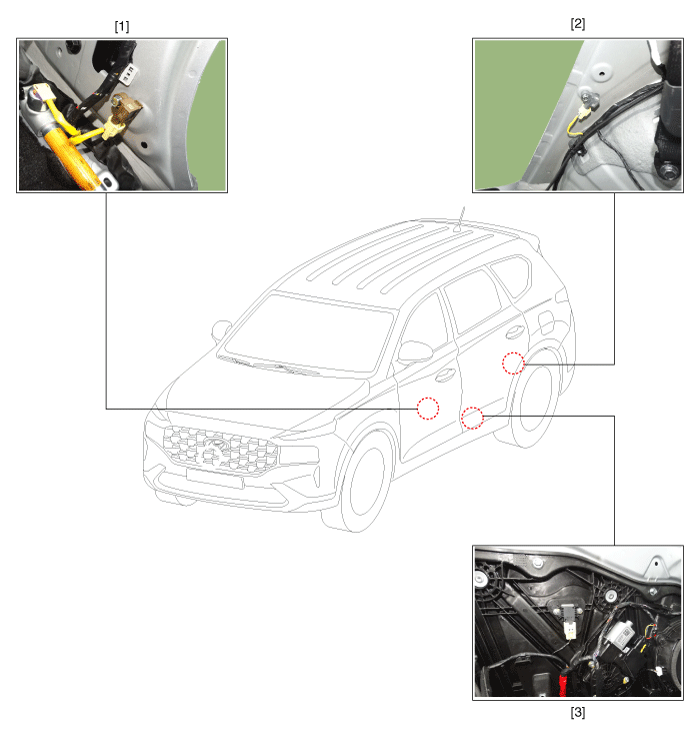
| 1. Gravity Side
Impact Sensor [G-SIS(B-Pillar)] 2. Gravity Side Impact Sensor [G-SIS(C-Pillar)] |
3. Front Pressure
Side Impact Sensor (P-SIS) |
Side Impact Sensor (SIS). Repair procedures
| Removal |
|
Pressure Side Impact Sensor [P-SIS(Door)]
| 1. |
Disconnect the battery negative cable, and wait for at least three minutes
before beginning work.
|
| 2. |
Remove the front door trim.
(Refer to Body - "Front Door Trim")
|
| 3. |
Disconnect the front side impact sensor connector (A).
|
| 4. |
Remove the front side impact sensor (A) by loosening the screw.
|
Gravity Side Impact Sensor [G-SIS(B Pillar)]
| 1. |
Disconnect the negative battery terminal, and wait for at least thirty
seconds before beginning to work.
|
| 2. |
Remove the center pillar trim.
(Refer to Body - "Center Pillar Trim")
|
| 3. |
Disconnect the connector (B) and then remove the side impact sensor
(A) after loosening the mounting bolt.
|
Gravity Side Impact Sensor [G-SIS(C-Pillar)]
| 1. |
Disconnect the battery negative cable and wait for at least three minutes
before beginning work.
|
| 2. |
Remove the luggage side trim.
(Refer to Body - "Luggage Side Trim")
|
| 3. |
Disconnect the connector (B) and then remove the side impact sensor
(A) after loosening the mounting bolt.
|
| Installation |
|
Pressure Side Impact Sensor [P-SIS (Door)]
| 1. |
Install the new front side impact sensor with the screws, then connect
the front side impact sensor connector.
|
| 2. |
Install the front door trim.
(Refer to Body - "Front Door Trim")
|
| 3. |
Reconnect the battery negative cable.
|
| 4. |
After installing the front side impact sensor, confirm proper system
operation:
Turn the ignition switch ON; the SRS indicator light should turn on
for about six seconds and then go off.
|
Gravity Side Impact Sensor [G-SIS (C-Pillar)]
| 1. |
Install the new rear side impact sensor with a bolt and then connect
the rear side impact sensor connector.
|
| 2. |
Install the luggage side trim.
(Refer to Body - "Luggage Side Trim")
|
| 3. |
Reconnect the battery negative cable.
|
| 4. |
After installing the rear side impact sensor, confirm proper system
operation:
Turn the ignition switch ON; the SRS indicator light should turn on
for about six seconds and then go off.
|
Gravity Side Impact Sensor [G-SIS(B-Pillar)]
|
| 1. |
Install the side impact sensor with the bolt then connect the side impact
sensor connector.
|
| 2. |
Install the luggage side trim.
(Refer to Body - "Luggage Side Trim")
|
| 3. |
Reconnect the battery negative cable.
|
| 4. |
After installing the pressure side impact sensor, confirm proper system
operation:
|
|
Seat Belt Buckle Switch (BS). Description and operation
| Description |
The SRSCM monitors the status of the driver and front passenger seat belt buckle.
The SRSCM provides one pin each for the driver and front passenger seat belt
buckle status input. The seat belt buckle circuit operates from internal boost
voltage supplied by the SRSCM, and uses chassis ground for the signal return.
The buckle status modify the SRSCM deployment. If the buckle status is unbuckled,
the corresponding pretensioner will not be deactivated.
Seat Belt Buckle Switch (BS). Components and components location
| Components |
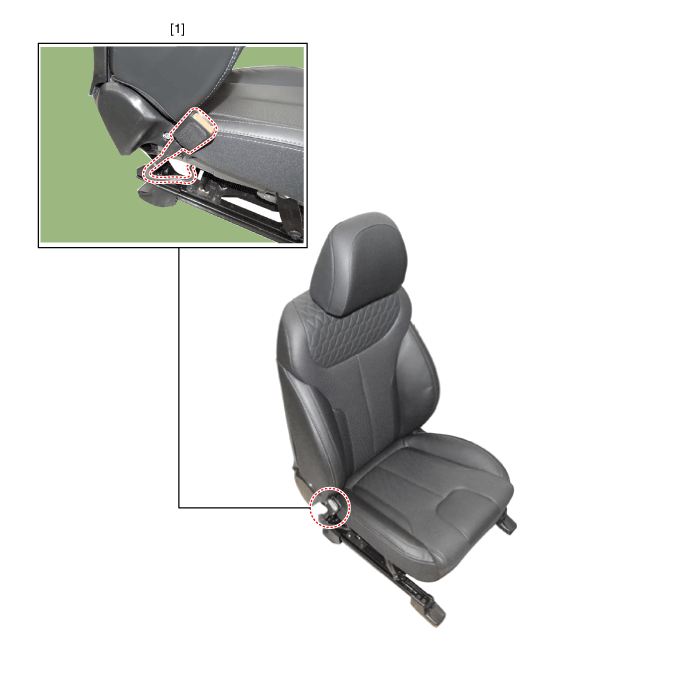
| 1. Seat belt
buckle switch (BS) |
Seat Belt Buckle Switch (BS). Repair procedures
| Removal |
| 1. |
Disconnect the battery negative cable, and wait for at least three minutes
before beginning work.
|
| 2. |
Remove the front seat assembly.
(Refer to Body - "Front Seat Assembly")
|
| 3. |
Remove the seat belt buckle switch wiring (A).
|
| 4. |
Remove the seat belt buckle switch by loosening the monuting bolt.
|
| Installation |
|
| 1. |
Install the seat belt buckle switch.
|
| 2. |
Install the front seat assembly.
(Refer to Body - "Front Seat Assembly")
|
| 3. |
Reconnect the battery negative cable.
|
| 4. |
After installing the seat belt buckle switch, confirm proper system
operation:
Turn the ignition switch ON; the SRS indicator should turn on for about
six seconds and then go off.
|
 Repair procedures
Repair procedures
Component Replacement after Deployment • Before doing any SRS repairs, use the GDS to check for DTCs. Refer to the Diagnostic Trouble Code list for repairing of the related DTCs. When the ...
 Airbag Module
Airbag Module
Driver Airbag (DAB) Module and Clock Spring. Description and operation Description The Driver Airbag (DAB) is installed in the steering wheel and electrically connected to SRSCM via the clock spring. It ...
See also:
Flex Steer. Schematic Diagrams
Circuit Diagram ...
Fuel Filler Door Release Actuator. Repair procedures
Inspection 1. Remove the left luggage side trim. 2. Remove the subwoofer. 3. Remove the fuel filler housing after opening the fuel filler door. 4. Loosen the fuel filler actuator mounting bolts (2EA). ...
Fuel Pressure Control Valve. Repair procedures
Inspection 1. Turn the ignition switch OFF and disconnect the battery negative (-) cable. 2. Disconnect the fuel pressure regulator valve connector. 3. Measure resistance between the fuel pressure regulator ...



